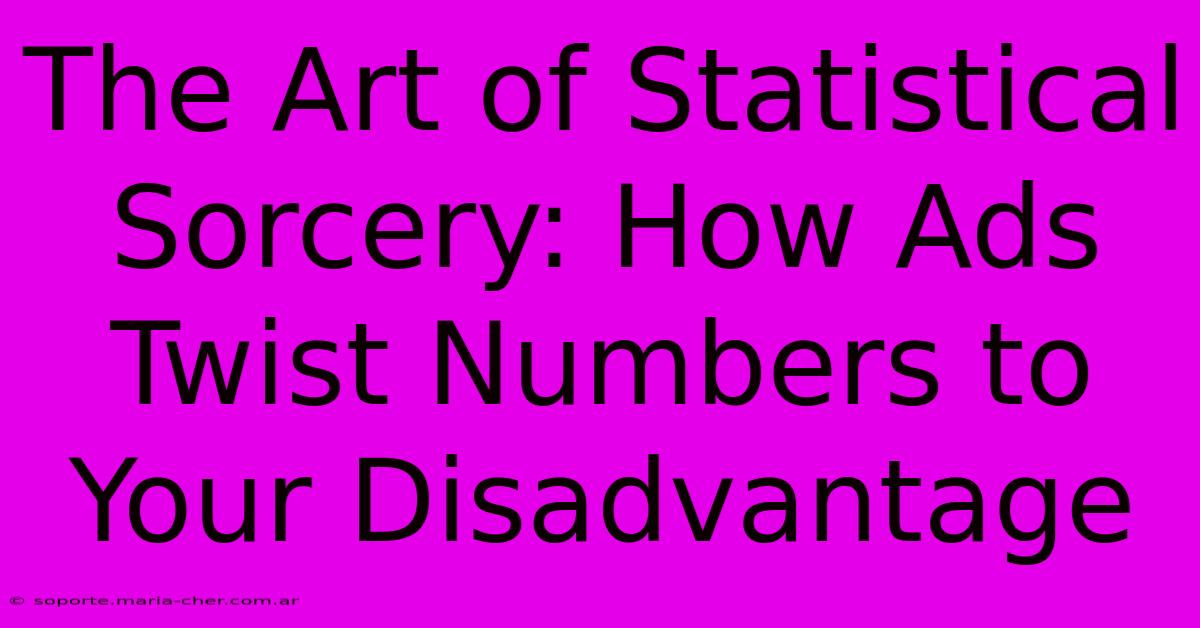The Art Of Statistical Sorcery: How Ads Twist Numbers To Your Disadvantage

Table of Contents
The Art of Statistical Sorcery: How Ads Twist Numbers to Your Disadvantage
We're bombarded daily with advertisements boasting incredible statistics. "90% effective!" "Lose 10 pounds in a week!" "Millions of satisfied customers!" But how often do we critically examine these claims? The truth is, many ads employ subtle (and sometimes not-so-subtle) statistical sorcery to manipulate our perceptions and influence our purchasing decisions. Understanding these tricks is the first step to becoming a more informed and discerning consumer.
Deceptive Data Displays: The Visual Illusion
One of the most common techniques is the misrepresentation of data through visual aids. Graphs and charts, when manipulated, can dramatically distort reality. Look out for:
- Truncated Y-axes: A graph might show a small increase as substantial by starting the y-axis far above zero. A seemingly impressive growth of 10% looks much less so when the entire range of the data is shown.
- Misleading Scales: Uneven spacing on axes can exaggerate or diminish changes. A subtly altered scale can make a small improvement appear enormous.
- Cherry-picked Data: Presenting only data that supports the desired conclusion while ignoring contradictory information is a classic tactic. Always look for the full picture, not just the highlights.
Example: An ad showing a weight-loss graph with a steeply downward slope might be using a truncated y-axis to make the results appear more impressive than they actually are. The total weight loss might be minimal in reality.
The Power of Ambiguity: Vague Claims and Hidden Details
Many ads rely on vague language to avoid making concrete, verifiable claims. Beware of terms like:
- "Up to": This allows the advertiser to claim a high figure while acknowledging that the actual result might be significantly lower. "Up to 50% off" could mean only a few items are discounted that much.
- "Clinically proven": This sounds impressive but lacks specifics. What was the study design? How many participants were involved? What were the actual results? Look for verifiable scientific evidence, not just buzzwords.
- "As seen on...": Just because a product appeared on a certain show doesn't necessarily mean it's effective or high quality.
Example: A skin cream ad boasting "Clinically proven to reduce wrinkles" needs further investigation. What is the definition of "reduce wrinkles"? Was it a small study with biased results?
Statistical Sleight of Hand: Misinterpreting Correlations and Causation
A common error is conflating correlation with causation. Just because two things happen together doesn't mean one causes the other.
- Correlation vs. Causation: Ads might suggest that using their product leads to a positive outcome, even if the relationship is purely coincidental.
- Missing Control Groups: Proper scientific studies include control groups for comparison. Without a control group, it's impossible to determine if the observed changes are due to the product or other factors.
Example: An ad claiming that drinking a particular juice leads to improved health might be misinterpreting a correlation; perhaps people who drink the juice already have healthier lifestyles.
Protecting Yourself From Statistical Manipulation
Becoming a savvy consumer requires a healthy dose of skepticism and a basic understanding of statistical principles. Here are some tips to protect yourself:
- Look for sources: Where did the statistics come from? Are they reputable?
- Consider the sample size: Were the results based on a small, unrepresentative sample?
- Ask for specifics: Demand more information about the methods used and the full data set.
- Be wary of sensational claims: Extreme promises rarely hold true.
- Do your research: Independently verify the claims made in the ad.
By understanding the common tricks advertisers use to manipulate data, we can become more critical consumers, making informed decisions based on facts rather than cleverly disguised fiction. The art of statistical sorcery may be impressive, but with a little knowledge, we can break the spell.

Thank you for visiting our website wich cover about The Art Of Statistical Sorcery: How Ads Twist Numbers To Your Disadvantage. We hope the information provided has been useful to you. Feel free to contact us if you have any questions or need further assistance. See you next time and dont miss to bookmark.
Featured Posts
-
Witness The Art Of Natures Canvas The Ultimate Guide To Landscape Photography
Feb 08, 2025
-
The Countdown To Halloween 7 Bone Chilling October Newsletter Ideas For Your Spine Tingling Audience
Feb 08, 2025
-
Natures Art Unboxed Secret Savings On Instagrammable Dried Flowers
Feb 08, 2025
-
Red Carpet Ready St John Evening Gowns That Steal The Spotlight
Feb 08, 2025
-
A Lesson Learned How We Ll Prevent Future Disruptions And Enhance Customer Experience
Feb 08, 2025
